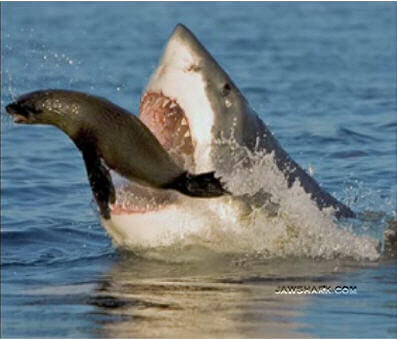MIAMI — A new study examining the complex and dynamic interactions between white sharks and Cape fur seals in False Bay, South Africa, offers new insights on the physical conditions and biological factors underlying predator-prey interactions in the marine environment.
University of Miami (UM) Rosenstiel School of Marine and Atmospheric Science assistant professor Dr. Neil Hammerschlag, and a colleague from the University of British Columbia, describe how sharks are camouflaged as they stalk their prey from below. Low-light conditions, from the optical scattering of light through water, along with a shark’s dark grey back and the dimly light rocky reef habitat allow sharks to remain undetected by seals swimming at the water’s surface.
“Animal hunting in the ocean is rarely observed by humans,” said Hammerschalg, director of the RJ Dunlap Marine Conservation Program at UM. “The high frequency of attacks by white sharks on seals at our study site in South Africa provides a very unique opportunity to uncover new insights about predator-prey relationships.”
Sharks typically search, stalk and strike their prey from below. The vast majority of predatory strikes by sharks and Cape fur seals occur against small groups of young-of-the-year seals. Predatory activity by sharks is most intense within two hours of sunrise and quickly decreases as light penetration in the water column increases.
“Stealth and ambush are key elements in the white shark’s predatory strategy,” said Hammerschlag.
Cape fur seals also have unique techniques to detect, avoid, outmaneuver and in some cases injure the white shark in order to avoid predation by sharks.
According to the authors, if a seal is not disabled during the shark’s initial shark, the small seal can use its highly maneuverable body to leap away from the shark’s jaws to evade a second strike.
The study, titled “Marine predator-prey contests: Ambush and speed versus vigilance and agility,” was published in the Nov. 30 online edition of the journal Marine Biology Research. Hammerschlag’s co-author is the late Dr. R. Aiden Martin.
About UM and the R.J. Dunlap Marine Conservation Program
The University of Miami (UM) is the largest private research institution in the southeastern United States. The University’s mission is to provide quality education, attract and retain outstanding students, support the faculty and their research, and build an endowment for University initiatives. Founded in 2009, the R.J. Dunlap Marine Conservation Program is a joint program of the Rosenstiel School of Marine & Atmospheric Science and the Leonard and Jayne Abess Center for Ecosystem Science and Policy. The Rosenstiel School offers one of largest, most comprehensive marine and atmospheric programs in the nation. The Abess Center encourages innovative interdisciplinary initiatives that bridge the gap between hard science and environmental policy. You can support us by visiting ShopforSharks.com. For more information, please visit http://www.rjd.miami.edu.
If our reporting has informed or inspired you, please consider making a donation. Every contribution, no matter the size, empowers us to continue delivering accurate, engaging, and trustworthy science and medical news. Independent journalism requires time, effort, and resources—your support ensures we can keep uncovering the stories that matter most to you.
Join us in making knowledge accessible and impactful. Thank you for standing with us!

